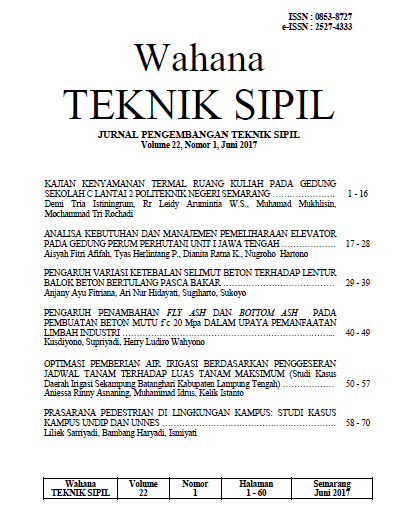Prasarana Pedestrian Di Lingkungan Kampus: Studi Kasus Kampus UNDIP dan UNNES
DOI:
https://doi.org/10.32497/wahanats.v22i1.902Abstract
Public infrastructure that supports mobility is closely related to the issue of sustainability. Research on pedestrian facilities at the university is a description of the extent to which pedestrian is used in Indonesia. The purpose of this research is to identify the pedestrian facilities, compare the availability of pedestrian facilities and to know the perception of the academic community from the case study of Diponegoro University Campus and Semarang State University. The research method used is case study with qualitative approach based on assessment of nine criteria of sustainable pedestrian. The comfortable and safe pedestrian conditions in the Undip Campus are the most powerful aspects of the correlation among the nine aspects that are compared. While in Unnes Campus, the feasibility of pedestrian and its easy to reach correlation is very strong against the level of satisfaction of respondents to Pedestrian infrastructure that exist today. The connectivity of pedestrian in Undip Campus is higher than in Unnes Campus, and it turns out that in other technical aspects it tends to be so. The similarity of the two campus locations that still do not meet the requirements of satisfaction is the use of pedestrian by the difable (with special needs). Based on the assessment of sampling point (59 points) from the pedestrian on the Undip and Unnes campuses, in general the two research sites have not fully implemented 9 sustainable pedestrian criteria. The need for pedestrian data collection and arrangement as part of the sustainable Campus development becomes the need of campus managers in the future
Kata kunci : Pedestrian, sustainable, campus
Downloads
Published
Issue
Section
License
Authors who publish with this journal agree to the following terms:Authors retain copyright and grant the journal right of first publication with the work simultaneously licensed under a Creative Commons Attribution License that allows others to share the work with an acknowledgement of the work's authorship and initial publication in this journal.
Authors are able to enter into separate, additional contractual arrangements for the non-exclusive distribution of the journal's published version of the work (e.g., post it to an institutional repository or publish it in a book), with an acknowledgement of its initial publication in this journal.
Authors are permitted and encouraged to post their work online (e.g., in institutional repositories or on their website) prior to and during the submission process, as it can lead to productive exchanges, as well as earlier and greater citation of published work (See The Effect of Open Access).






